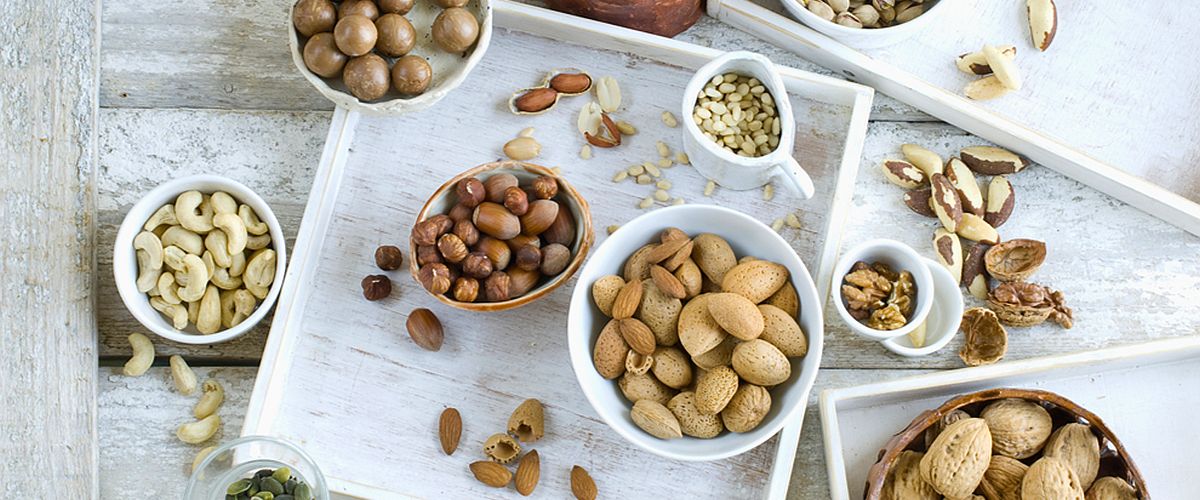Crunch! Few things are more satisfying than a handful of almonds, sunflower seeds, or whatever your favorite nut or seed may be. We crave their roasted flavors and inviting textures, especially in cooler weather.
But wait, aren’t nuts and seeds high in fat and calories? If you think you need to avoid peanuts, pistachios, and pumpkin seeds for that reason, think again. Not only are nuts and seeds tasty treats, but they pack a nutritious punch.
“Nuts and seeds sometimes get a bad rap, but they are important for a healthy, balanced diet,” shares Aramark Registered Dietitian Nutritionist Taylor Koenigs, MS, RDN, LDN. “The key is to choose the right preparation and be mindful of serving sizes.”
We tapped Taylor to better understand the health benefits of nuts and seeds, plus the many ways to enjoy them. Read on!
Great Things in Small Packages
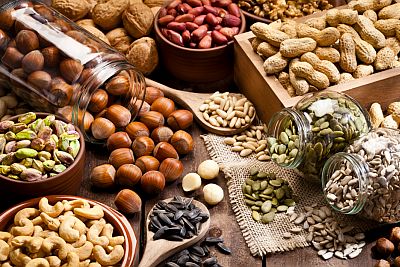 According to research, eating nuts and seeds is associated with a lower risk of developing high blood pressure, heart disease, cancer, and other conditions. To understand why, it helps to consider what nuts and seeds are: the genesis of other plants.
According to research, eating nuts and seeds is associated with a lower risk of developing high blood pressure, heart disease, cancer, and other conditions. To understand why, it helps to consider what nuts and seeds are: the genesis of other plants.
Nuts (such as almonds and walnuts) are the seeds of trees. Meanwhile, the foods we call seeds are the seeds of vegetables and related crops (think flax and sunflower). And, as many of us learn at some point in our lives, peanuts are technically legumes because they grow underground—but from a nutritional and culinary standpoint, they count as nuts.
All this helps explain why nuts and seeds are so dense with nutrients. Their stellar nutritional pedigree includes:
- Plant protein: This makes nuts and seeds a favorite among people who follow a plant-forward lifestyle. In fact, from Mediterranean to Paleo, it’s hard to find an eating pattern that does not welcome nuts and seeds onto the menu.
- Unsaturated fats: Don’t let this part scare you. “These are the heart-healthy or ‘good’ fats that can help lower bad cholesterol and reduce inflammation,” Taylor explains. “You want to be eating the kind of fat found in nuts and seeds, in moderation.” Walnuts and flax seeds, in particular, are a yummy way to get omega-3s, a type of unsaturated fat that as part of a healthy diet can help with brain health, joint pain, and even reduce the risk of stroke.
- Fiber: Fiber has been shown to boost your gut health and keep you feeling full between meals, which can help you reach and maintain a healthy weight.
- Low glycemic index: Because they are so low in carbohydrates, nuts and seeds will not raise your blood sugar in the same way other foods can. What’s more, nuts like walnuts, almonds, and pecans have also been shown to improve insulin sensitivity, which can play a role in a healthy diet that helps manage or prevent diabetes.
- Vitamins and minerals: Nuts and seeds are chockfull of many other nutrients, including the antioxidant vitamin E, magnesium, and selenium.
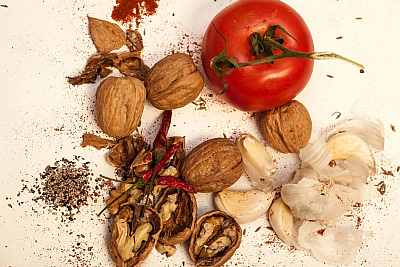
Recipe: Walnut Taco Filling
As a dietitian, Taylor is especially fond of walnuts, Brazil nuts, hazelnuts, almonds, pistachios, chia seeds, and flax seeds—but she encourages everyone to mix it up.
“Every nut and seed has its own unique nutritional profile,” she points out. “As with your overall diet, you should plan to eat a variety of nuts and seeds to maximize the health benefits. Plus, that way you won’t ever get bored!”
Here’s a handy chart that compares the calorie and fat (saturated and unsaturated) content of some common nuts and seeds.
Before You Go Nuts…
Ready to get cracking? Remember that any added salt or sugar can send your healthy snack downhill. “If you only eat nuts and seeds that are honey-roasted or chocolate-covered, the sugary coating can quickly overshadow any health benefits,” Taylor warns. “It’s best to stick to varieties that are unsalted and uncoated most of the time. The good news is that nuts and seeds are delicious on their own.”
Also, a little goes a long way. Most of the calories in nuts and seeds come from healthy fats—but a calorie is still a calorie. The standard serving size is 1 ounce of whole nuts or seeds (about a small handful) or 2 tablespoons if you’re eating them in butter form. Most adults should aim to eat four to six such servings each week.
“I always recommend measuring out your portions, especially with calorie-dense foods like nuts and seeds,” Taylor adds. “When you eat straight out of the container, you tend to consume more than you expect.”
Ways To Mix It Up
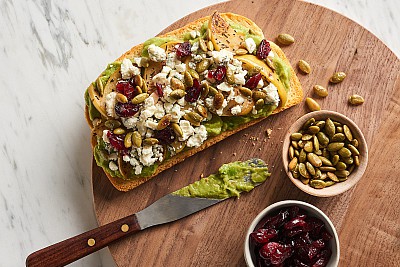
Recipe: Harvest Avocado Toast with Pumpkin Seeds
In addition to being nutritional powerhouses, nuts and seeds are relatively inexpensive. They also store well in your pantry and are super-easy to carry around as a snack. (Even better if you choose nuts and seeds over processed snacks like chips or pretzels.)
But snacking is just the beginning! Here are a few ways nuts and seeds can add flavor to and enhance the nutrition of your meals:
- Make homemade granola to sprinkle on top of your Greek yogurt, oatmeal, or fro-yo.
- Add pleasing crunch to salads and avocado toast.
- Crush nuts (like pecans or pistachios) and use them when “breading” chicken and fish.
- Swap out some of or all the meat in your next stir fry or taco night.
- Mix pine nuts or sunflower seeds into brown rice, quinoa, or couscous for a fresh take on a classic side dish.
- Spread nut or seed butter on whole-grain bread, apples, bananas, or celery sticks (ants on a log, anyone?).
- Put a teaspoon of chia seeds into your next smoothie.
- Use nut oils when cooking or in homemade salad dressing.
- Try nut flours as an alternative to wheat flour when baking.
- Substitute nut milk for dairy milk—although, again, watch out for added sugar.
A Note on Food Allergies
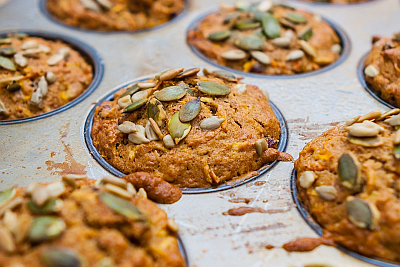
Recipe: Super Seed Carrot Apple Muffins
As peanuts and tree nuts are among the eight most common food allergens in the U.S. (and sesame was recently recognized as the ninth), we would be remiss if we didn’t mention food allergies. In her role at a major university in the U.S., Taylor has experience guiding students toward campus meals that are both nutritious and inclusive of allergies and other dietary needs.
So, what’s a person with a nut or seed allergy to do? For starters, you can try the ever-growing list of products made from alternative ingredients. For example, someone with a peanut allergy may be able to safely eat almond, sunflower, or soy butter.
Or, Taylor advises, you could turn to other foods entirely. “Nuts are not the only way to get these nutrients,” she says. “You can get your fiber from fruits and veggies, your omega-3 fatty acids from salmon and other fatty fish, your protein from lean meats, and so on.”
No matter what, always check the nutrition facts and ingredients label to make sure your allergen isn’t present in a food. If you’re dining away from home, ask! And if you have questions about what you can safely eat, speak with your allergist.
Note: Since everyone’s health history and nutritional needs are so different, please make sure that you talk with your doctor and a registered dietitian to get advice about the diet and exercise plan that‘s right for you.

